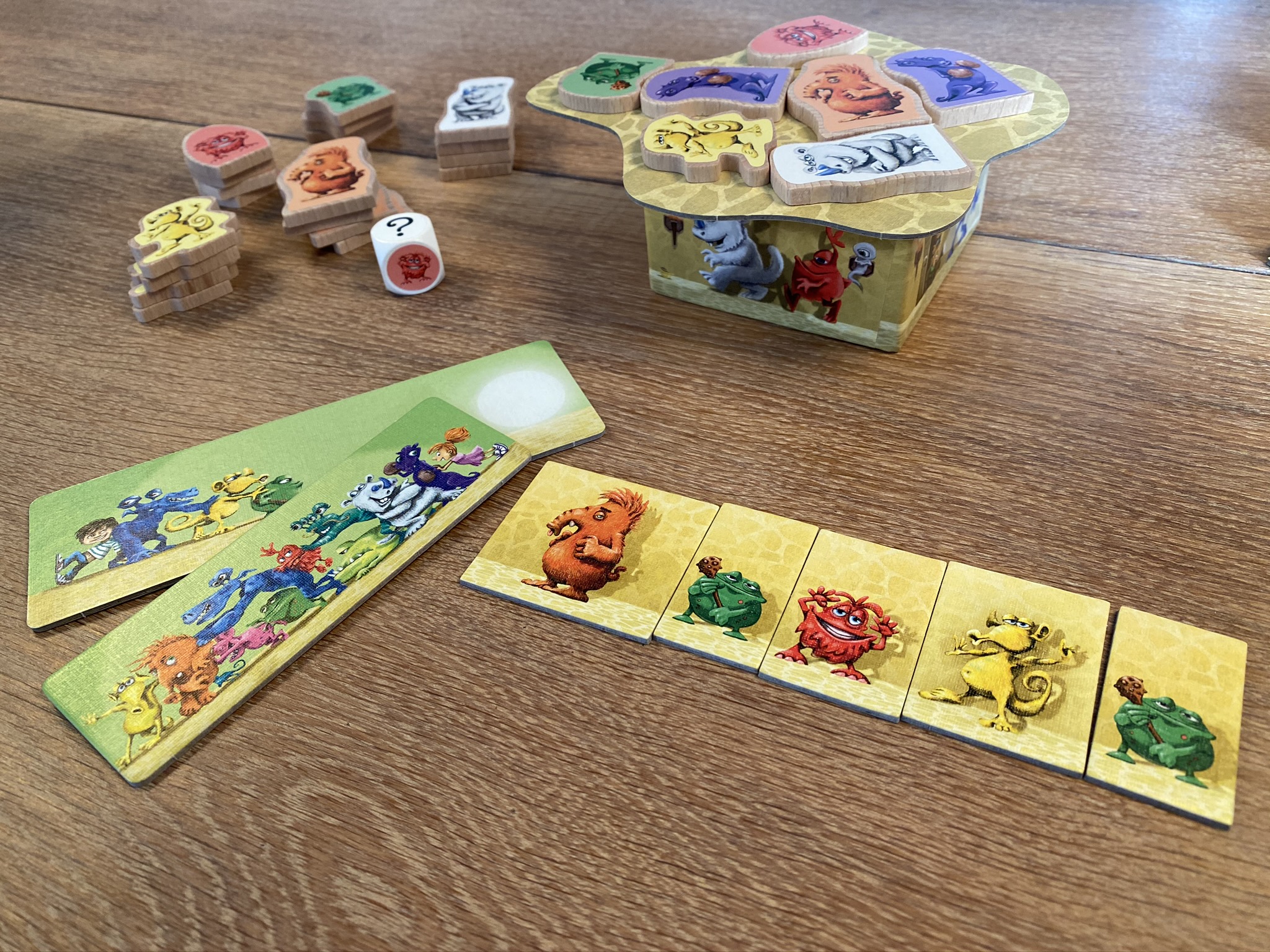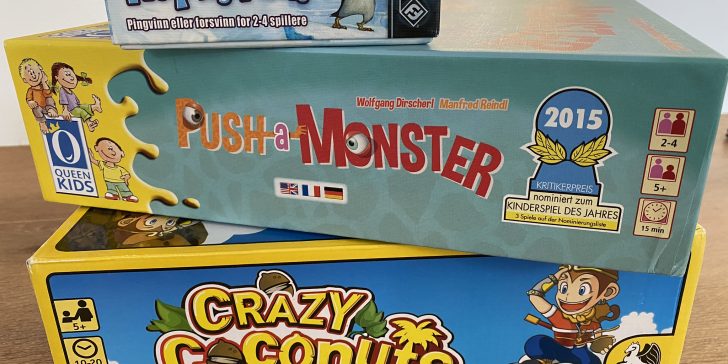
I have had so much for playing lighter games, suitable for kids with both my boyfriend, colleagues and other people, so I thought I would make a list of some of the must fun I have tried.
The games are sorted in order to age, and not ranked as it’s a bit hard to rank them as some are great because they are simple and fun and some are for a bit older kids.
There are so many games that are fun for adults to, so this is just a few of those that fit. Many dexterity games are fun for adults as well. It’s fun not to always be so serious 🙂
Penguin Trap (Don’t break the Ice)
(Age: 3+, Players: 2-4)
Nerve racking, but simple dexterity game, where you have to knock out pieces of ice, but not being the one making the penguin in the middle fall down. With the game comes a little spinner with action selection – it comes in different versions, either just 1 piece in different colors or 2 at a time, but in common for them all is the free pass, where you don’t have to knock out a piece.
It’s amazing, how little ice the penguin requires to still keep standing, as the blocks are in tension, so they are keeping each other up. The blocks also behave a bit unexpected, sometimes you accidentally knock out more than needed, as they where connected. It’s a fast paced game, suitable for all ages – even grandmas has been seen playing this.
https://boardgamegeek.com/boardgame/225981/penguin-trap
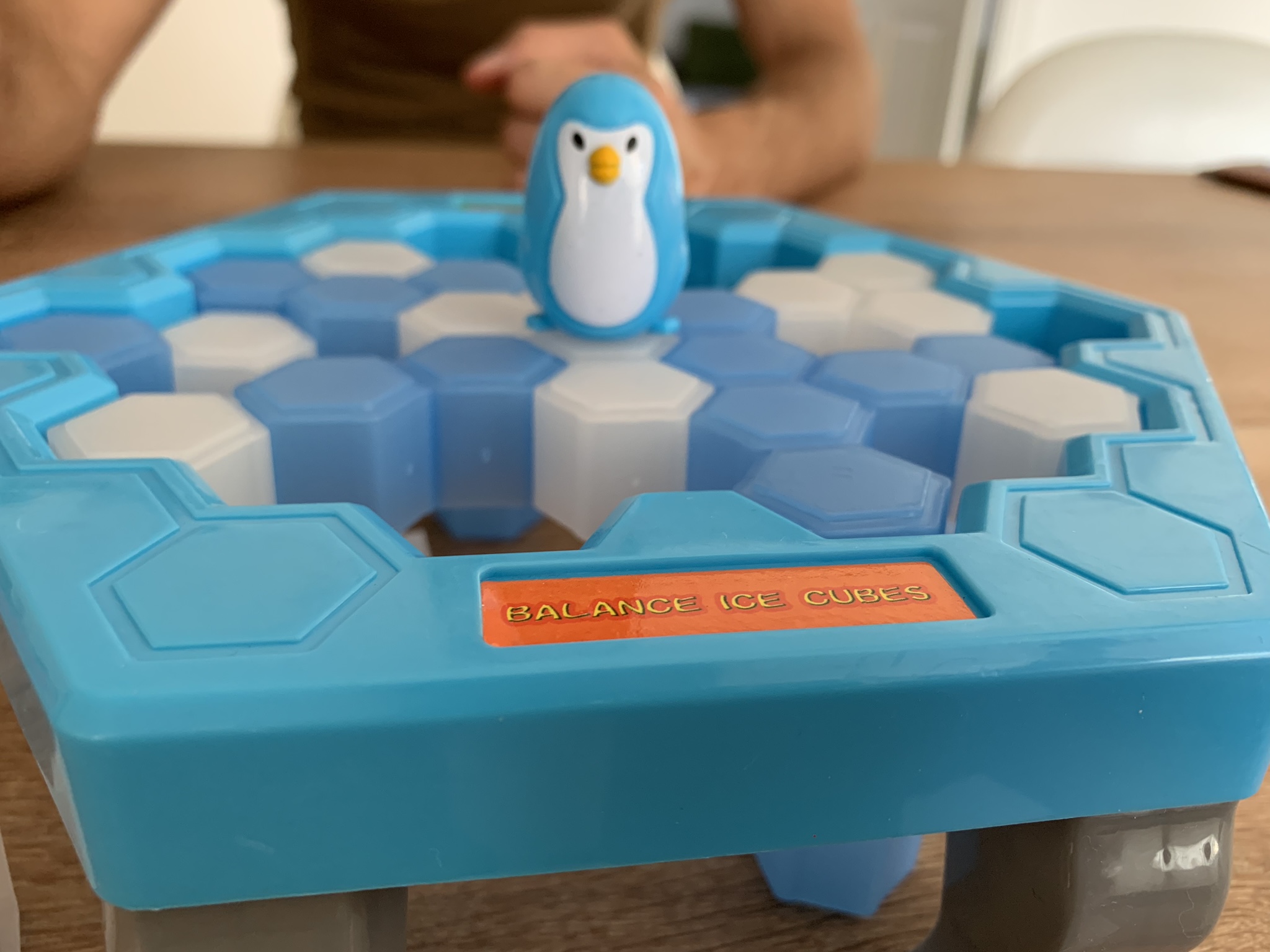
Animal Upon Animal (or Animal Upon Animal: Small Yet Great)
(Age: 4+ (5 for the small), Players: 2-4)
This is the original 2-4 player game, where you can play with a bit younger kids as the pieces are bigger. It’s also a bit easier for adults, but you might get unlucky, but the small game “Animal Upon Animal: Small yet Great” is more suited to mess with bigger hands getting in the way of building. It’s still a nice stacking game and it’s fun to be able to create fun towers of animals.
Each player has the same amount of animals (unique) and roll a die to determine how many animals to play – you might even get lucky that your opponent has to place your piece or unlucky in that the opponent has to choose which to play. You get punished for knocking pieces of, but no matter how many, you have to keep at most 2 extra pieces, so you actually have a change to get rid of them.
https://boardgamegeek.com/boardgame/17329/animal-upon-animal

Animal Upon Animal: Small Yet Great
This is a 2-player game which contains very small animals and you need to be 5+. And this is exactly what makes this game a little trickier than the original. This is a very quick and very travel friendly game, but of course only for 2 players – if you want for 4 players, you could either get 2 copies or play the original. It’s a bit shorter game, as you have 1 animal less.
Kids might have an advantage with placing small pieces on top of each other, if they are not too young, as their little fingers can easier handle and place the pieces.
https://boardgamegeek.com/boardgame/104805/animal-upon-animal-small-and-yet-great
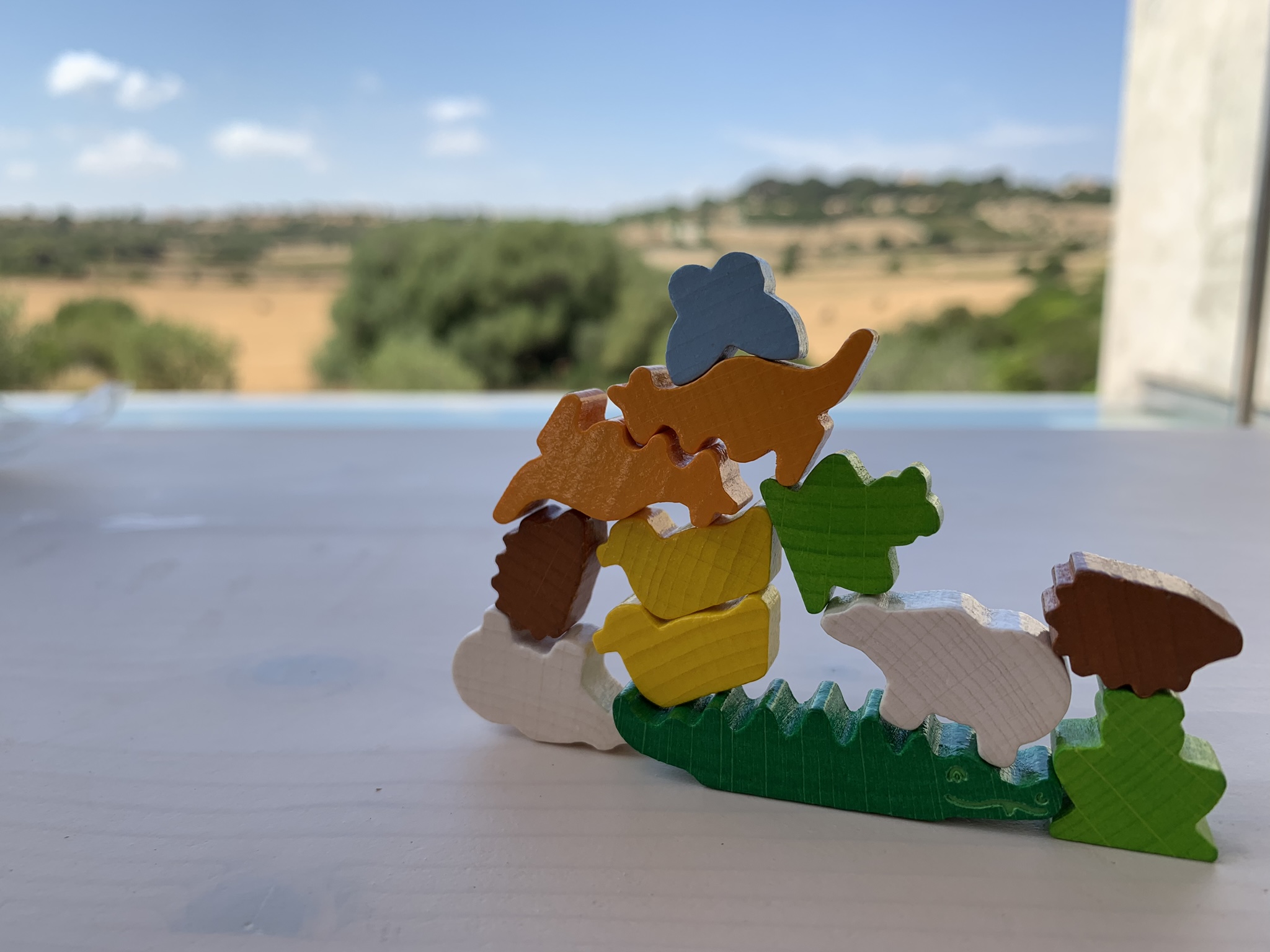
Rhino Hero
(Age: 5+, Players: 2-5+)
The rules are simple with a few twists. You have a few roof cards, you need to get rid off in order to win. Together you build a multi-story house, but you are not working together.
Place the walls (from the common pool) on the designated lines on the previous roof. Finish you level with placing a roof card (or in special cases 2) – only then is your turn over. Most of the roof cards have special abilities, many with placing our Rhino Hero; which has to be moved from his previous spot in order to finish your turn. Some cards have abilities as you know it from UNO – skip a turn, change direction, draw cards.
I know the object of the game is to get rid of all your cards, but mostly the game ends with one loser, then one making the building fall.
Box says 2-5 players, but we have also played with a few more, as there are plenty of roof cards.
It’s kind of the opposite of Jenga (Klodsmajor) with some abilities from UNO.
https://boardgamegeek.com/boardgame/91514/rhino-hero
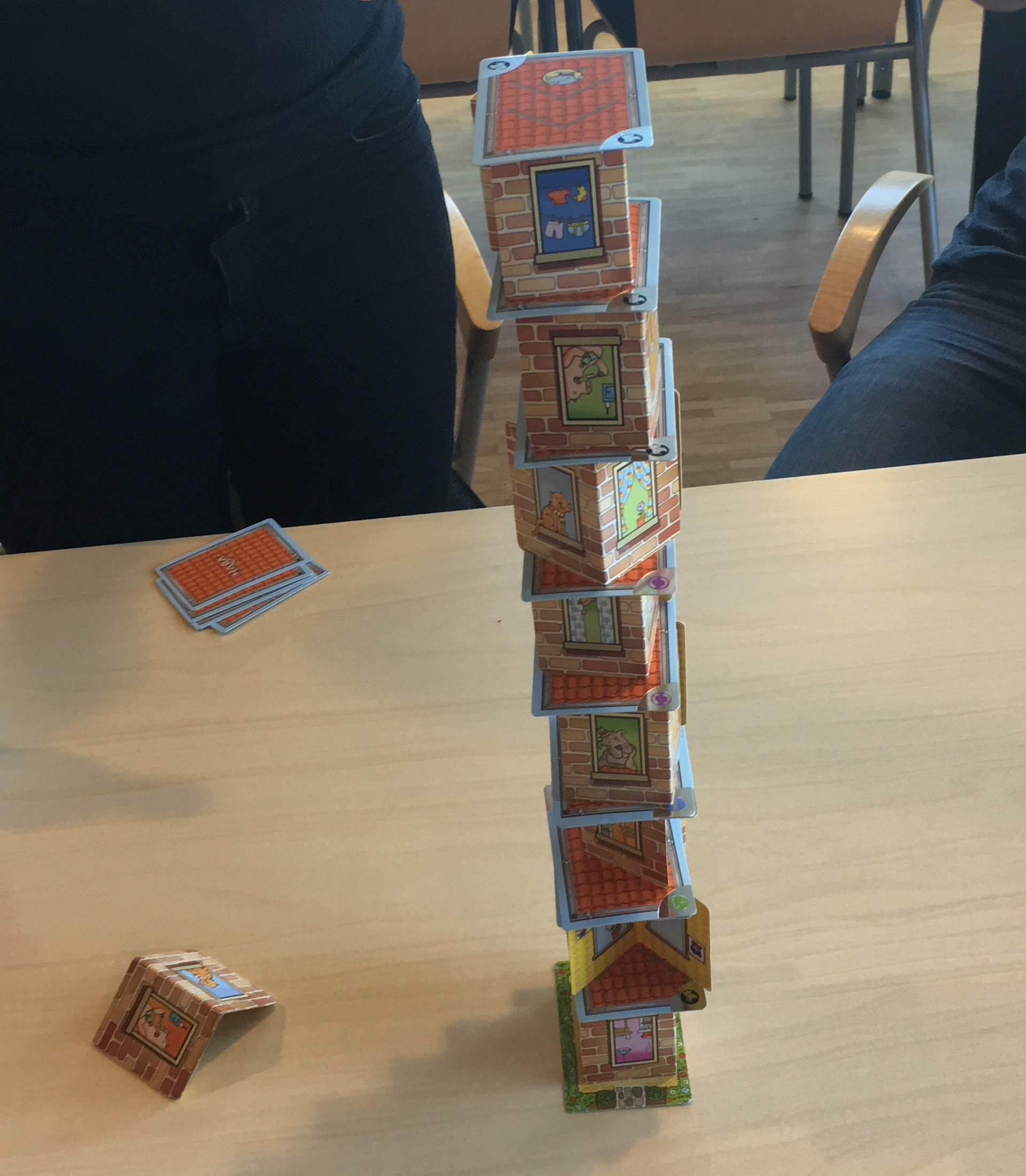
Rhino Hero: Super Battle
(Age: 5+, Players: 2-4+ (5 combined with Rhino Hero))
This is a new version of Rhino Hero, with a more battle elements and claiming the top than balancing pieces, as they seem more stable though there are those small pesky monkeys having from the building. This game requires a lot of ceiling space. It’s a race to the top and to stay there when the tower falls, but not being the one knocking it over – otherwise all other players win.
When you build a new floor on the building with the new requirements of building low or tall walls (and maybe placing a spider monkey), you roll the die to see if you go up (and how far). After movement you check to see if any battles occur; meaning at least 2 pieces are on the same floor – it doesn’t have to be the same roof tile, but the same level is checked. The attacker rolls the red die (higher numbers) and the defender the blue die (lower number). If you win you get to stay on that floor, but if you lose you go down (possibly causing a new battle).
Combining that game with Rhino Hero makes it possible to play up to 5 players.
https://boardgamegeek.com/boardgame/218333/rhino-hero-super-battle

Click Clack Lumberjack (Toc Toc Woodman)
(Age: 5+, Players: 2-7)
Another simple dexterity game, but more tricky. In order to score points, you have to knock off the bark of the tree trunk, but avoiding the actual truck core being knocked down, as this will score you negative points. You have 2 knocks per turn, and you HAVE to use both knocks, even if it will make it better for your opponents. You continue until all the bark is gone (it might also mean the core is gone, but not necessarily).
If you feel it’s too easy you can play with the different color of bark scoring different amount of points, making you go for certain bark to get even more points. It says it plays a maximum of 7 players, but actually there is no limit, but of course you will get less turns and points, playing more people. It’s a quick game, which like Jenga could end up making a lot of noise when it finally falls to the ground.
https://boardgamegeek.com/boardgame/39206/click-clack-lumberjack
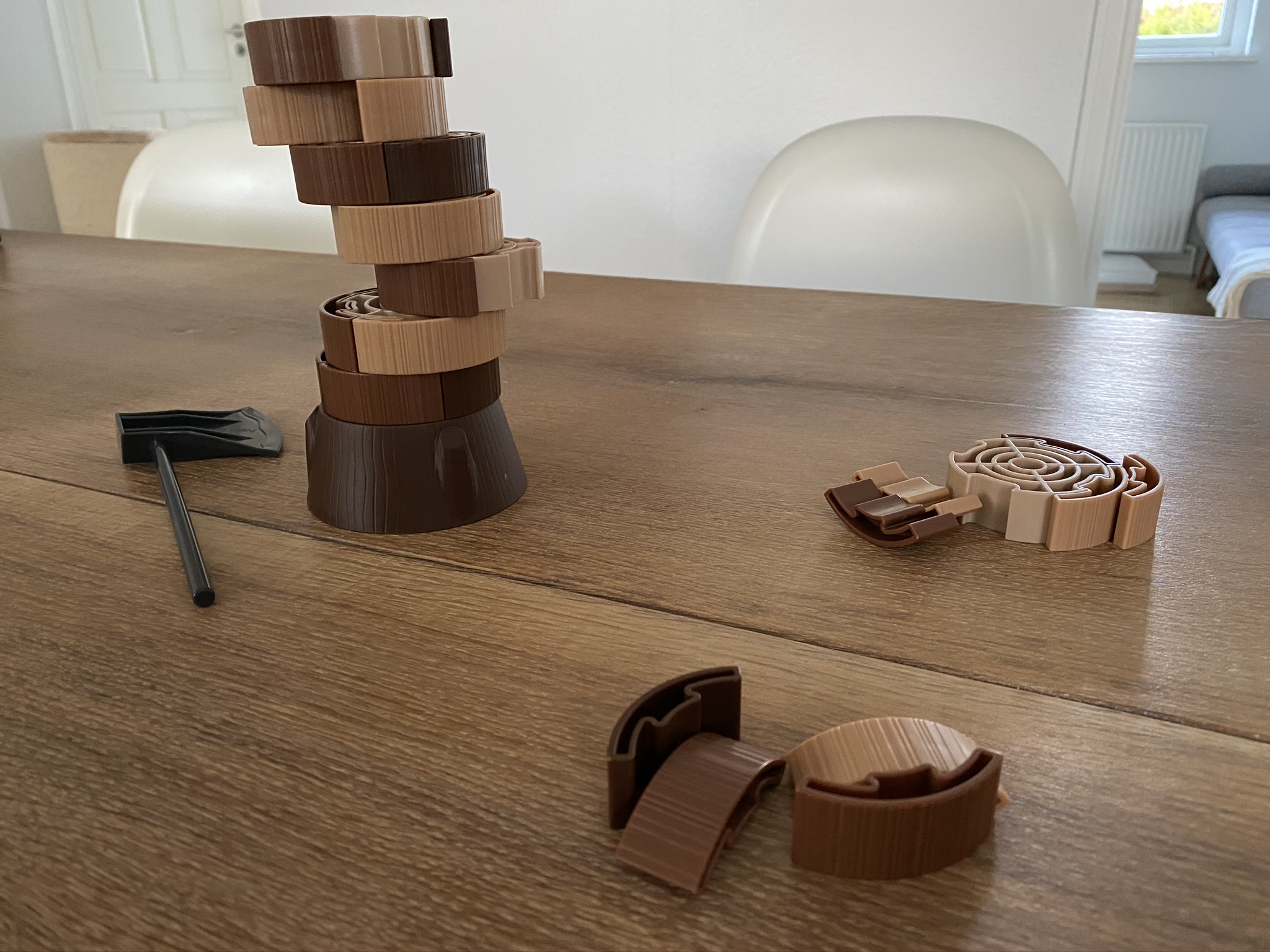
Coconuts (Crazy Coconuts)
(Age: 6+, Players: 2-4 (up to 8 with 2 copies, or with Coconuts Duo 6))
Be warned coconuts will be flying everywhere :D. In this game you have your own slingshot monkey shooting coconuts to try and hit the cups placed in front of it. It seems like it’s easy, but those coconuts has a mind of their own and bounces unexpectedly; sometimes in your favor but mostly not. If you get a coconut in a cup, you get to take it and place it on your own play mat, where you want to build a tower of 6 cups in order to win the game. If you hit a red cup, you get another turn. When someone has collected their first cup, it’s possible to try and take that away from them, but getting a coconut in their cup. If no one get’s to build the tower of 6 cups, you play until all coconuts are used and count each coconuts in the cups on the players play mat to find the winner.
The game say 2-4 players, but with the duo pack setup for 6 players are included to mix with the big game. I have taken it farther and just bought 2 copies, combing them to a 8 player madness game, but also has the flexibility of just playing 2 x 4 players.
https://boardgamegeek.com/boardgame/145639/coconuts
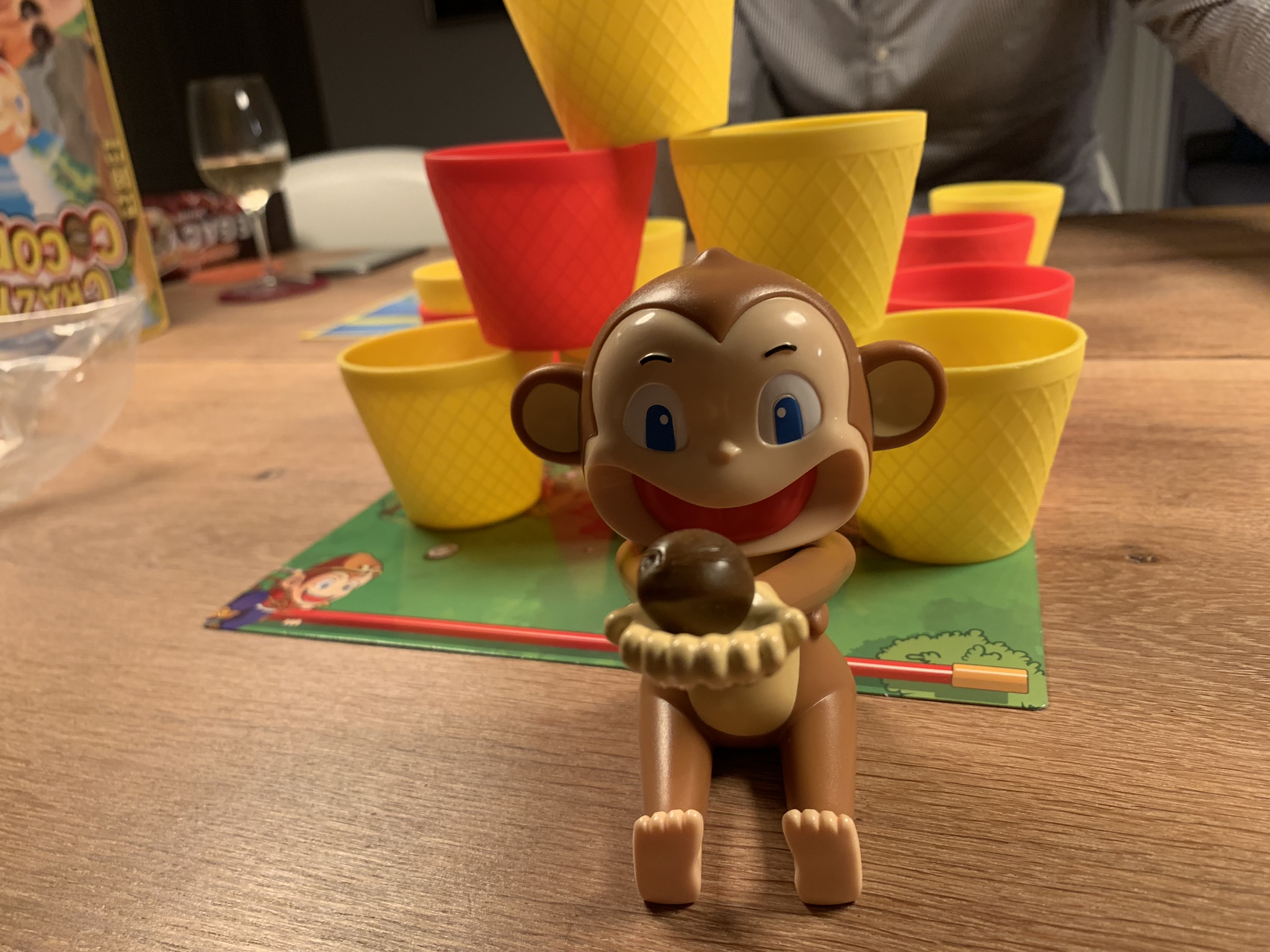
Icecool
(Age: 6+, Players: 2-4 (up to 8 combined with Icecool 2)
Unexperienced players will have fingers hurting after flicking penguins through door ways (or over if you are lucky) to get the best and most fish. You are penguins in school skipping class to get some fish for a snack and avoiding the school hall monitor. Every round a new player will play the hall monitor trying to catch the students before they get all their fish.
The nice thing about this is the unexpected movement of the penguins and it requires some practice to flick them the way you need them – and there are a few flicking tips in the rule book to try.
If you have both versions of Icecool you can combine to play more players or team version, but also just making the challenge harder (having to get more fish or places more apart).
https://boardgamegeek.com/boardgame/177524/icecool
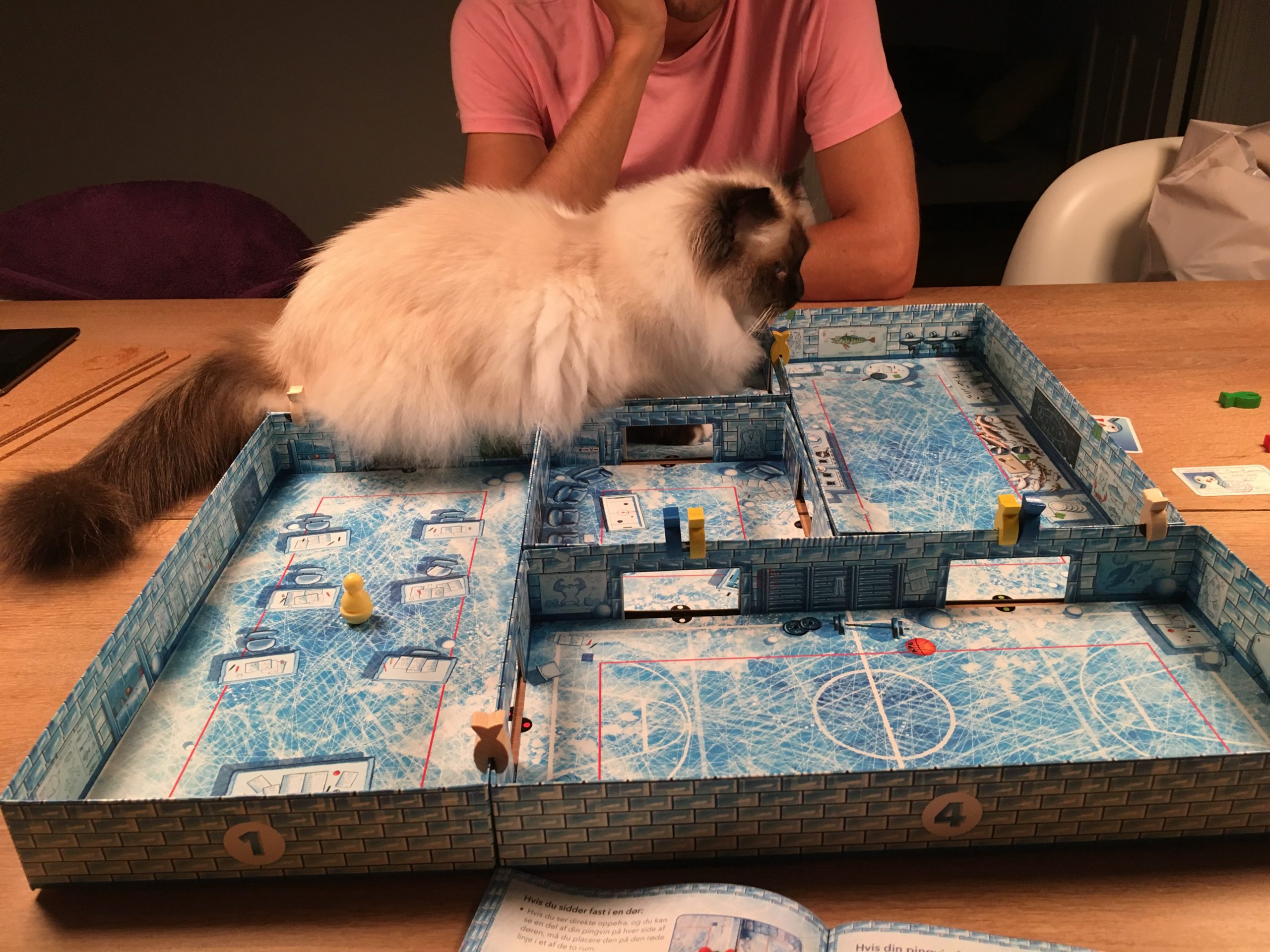
Bugs in the kitchen
(Age: 6+, Players: 2-4)
This is really a new kind of game for me, I have not seem the use of electric bugs running around. So you have a box with a lot of spoons, forks and knifes functioning as walls in a maze, and it’s your job to get the bug in the opponents end (or in the alternative version get the bug in your end), buy rolling a die of which type of utensil you can turn, but you have to be quick as that little electric bug moves very unexpected at times; you have to open and close the right utensil. It can be a little stressful, and I would recommend not waiting and thinking to long about which utensil wall to turn, as it makes the game a bit boring if it feels like you are just waiting for the bug to go a certain way.
https://boardgamegeek.com/boardgame/137909/bugs-kitchen
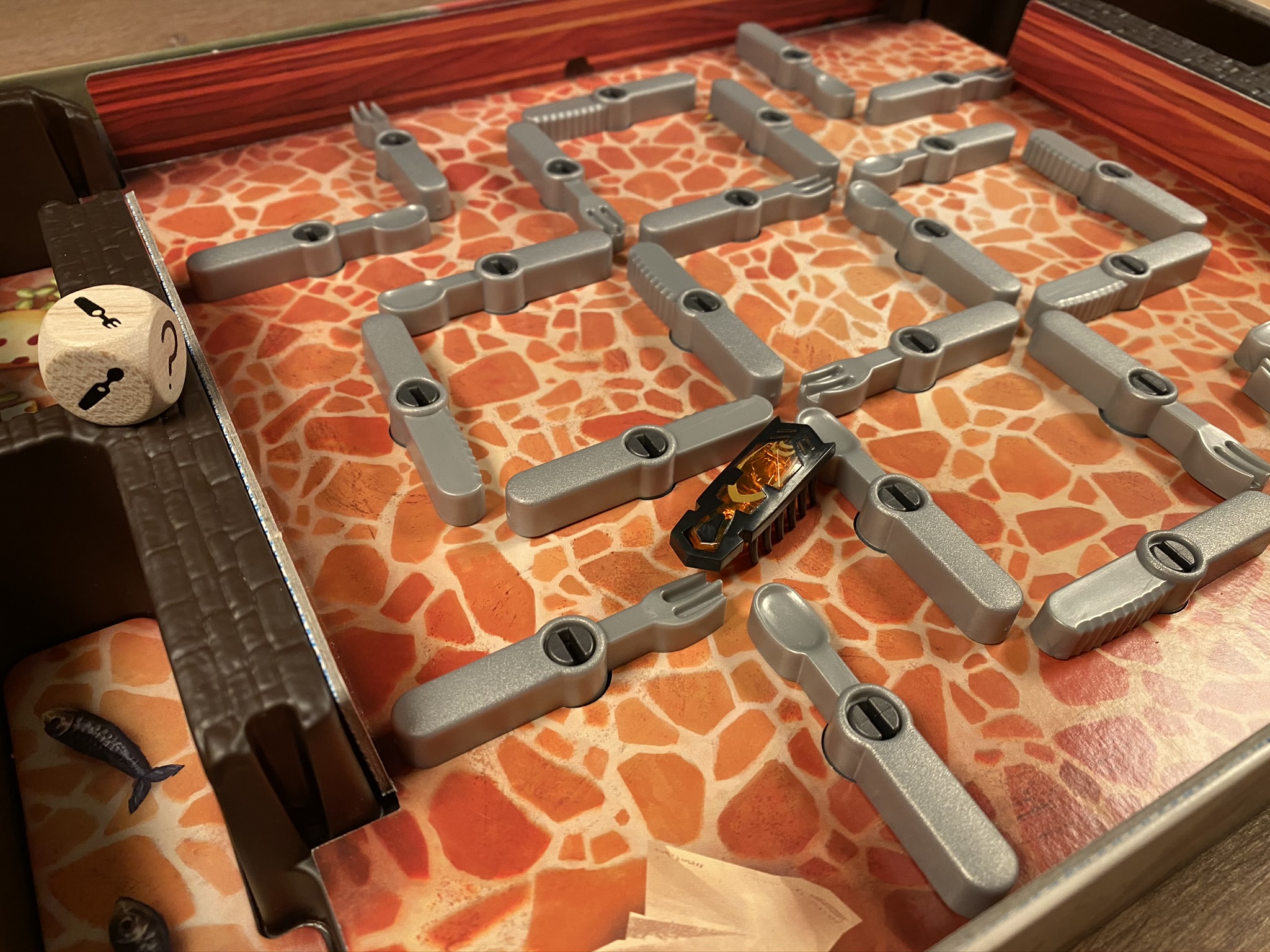
Happy Salmon
(Age: 6+, Players: 3-6 (up to 12 combined with the other version))
A fast paced and chaotic party game, but so lighthearted it’s fun. You stand around a table with a deck of 12 cards and simultaneously you start flipping your deck and start making the gestures for each card (4 different) and try to find another person who needs to make the same gesture and when you match you get to throw away one of your cards. The first to get rid of all their card is the winner. Usually a game takes less than a minute.
https://boardgamegeek.com/boardgame/194626/happy-salmon
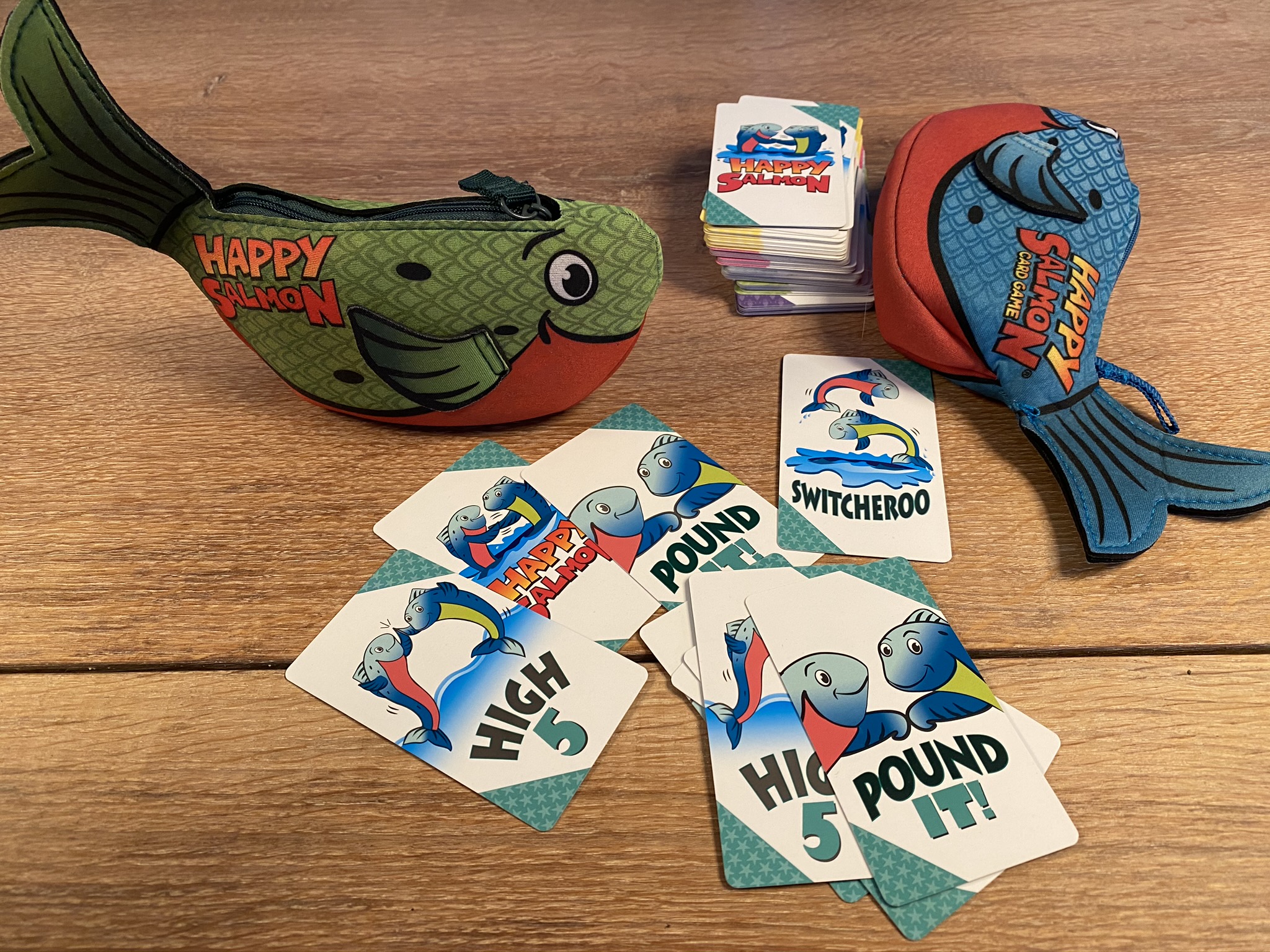
Bandido
(Age: 6+, Players: 1-4+)
Don’t just a game by it’s small box, this one takes up quite a lot of table space, but it’s very simple to play. It’s a co-op game and together you have to make sure the prisoner doesn’t escape – you do this by playing cards to close the tunnels or maybe if you are lucky making 2 tunnels connect to each other. You start with a prisoner in the middle of the table (either 5 or 6 exits) and all players have 3 cards in hand. On your turn you play a card matching one of the previous cards (matching graphics, black with black and brown with brown). You can’t talk about your cards, but we have house ruled it to say something like “don’t play here” or “I can play something that closes something”. Either way, make up your own rules to fit your group and maybe younger children. Be careful not to close too many tunnels to quickly as you only have a limited about of end cards and you might end up making so many extra tunnels, as you can only play in one spot.
The box says 1-4 players, and it’s quite difficult playing solo, and i haven’t managed to win yet. We have played this game with 5 and 6 players as well – not sure if it makes it too easy, but we have also added in an extra set of the game (at least the starting card). So I think there is a variety of playing options here.
https://boardgamegeek.com/boardgame/191925/bandido
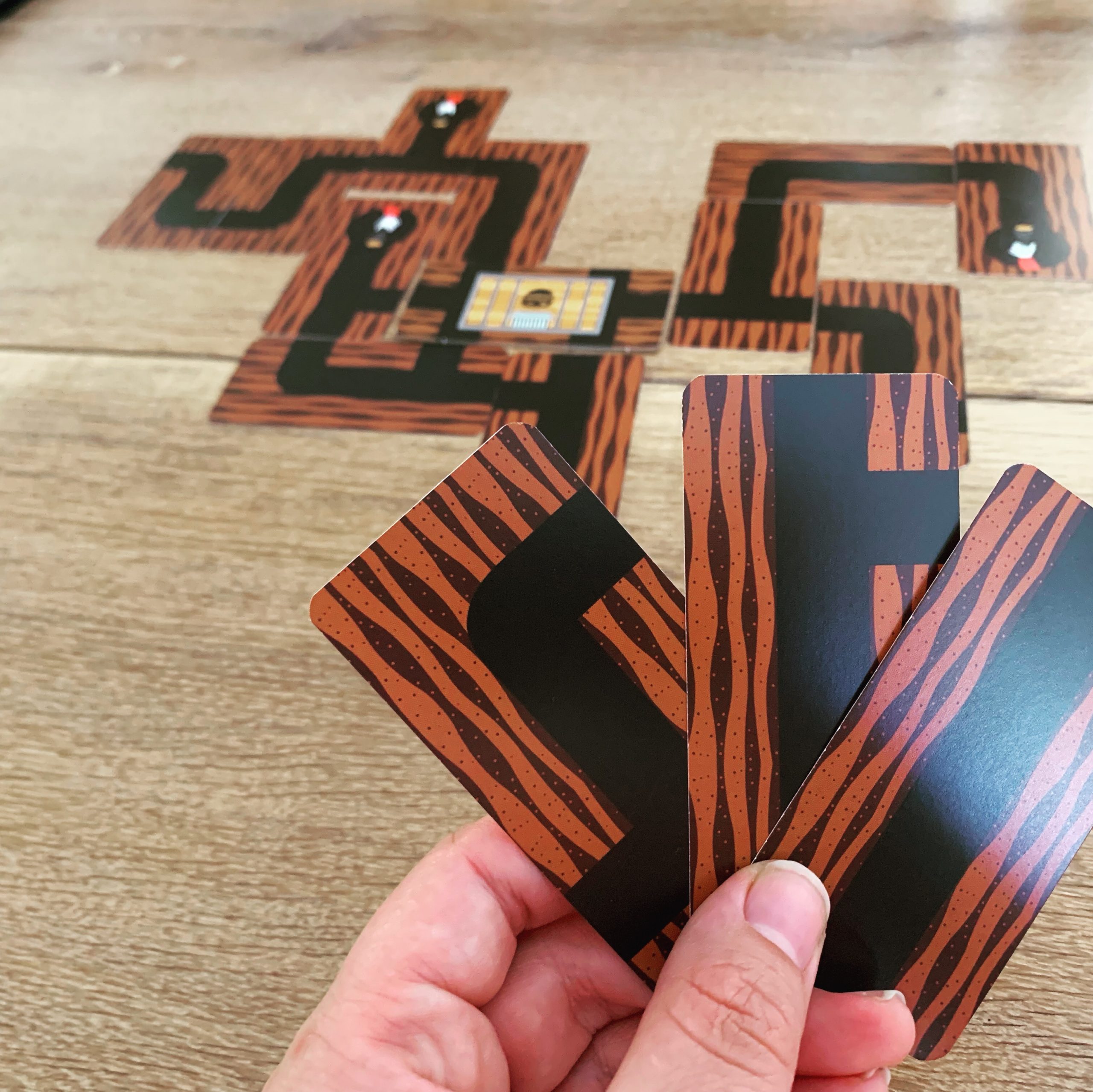
Bugs on Rugs
(Age: 6+, Players: 2-5)
Even the name is fun to say, Bugs on Rugs. There is actually more to it than just a cute theme and graphics, if played with the full set of rules there is a lot of strategic thinking. The game says it’s for age 6+, but there is a lot to keep track of. I imagine playing with this young you would need to play with only a few bug rules and add on later or maybe just collecting animals. It’s a quick game with collecting bugs, from a pool of public cards each round. The card that is not picked activates a specific action – it could be players passing a card to each other or having to discard a card. Each bug has a different scoring mechanism, some focus on the types of rugs the bugs are on and some requires you to have a certain amount of them to score (in some you score 0 if you have too many).
https://boardgamegeek.com/boardgame/257349/bugs-rugs/images

Battle Sheep
(Age: 7+, Players: 2-4)
The idea behind the game is an area majority mechanics – with how many sheep you can spread out. It reminds me of the game “Hey, that’s my fish” but differs a little bit.
Together you form the playing area (the grass tiles) and then you pick a spot at the border to put your stack of 16 sheep, ready for battle. On your turn you move your sheep in a straight line until you either hit the border or another sheep (opponent or your own), then you decide how many sheep from the stack you want in the new spot. The game ends, when both players can move anymore. You count how many spots you occupied (how many sheep you deployed) with sheep; most wins. What differs from the game “Hey, that’s my fish” is you can always see if you are ahead or losing, and the counting of points is easier. It also doesn’t seem as mean, like cutting someone of on a small floe.
https://boardgamegeek.com/boardgame/54137/battle-sheep
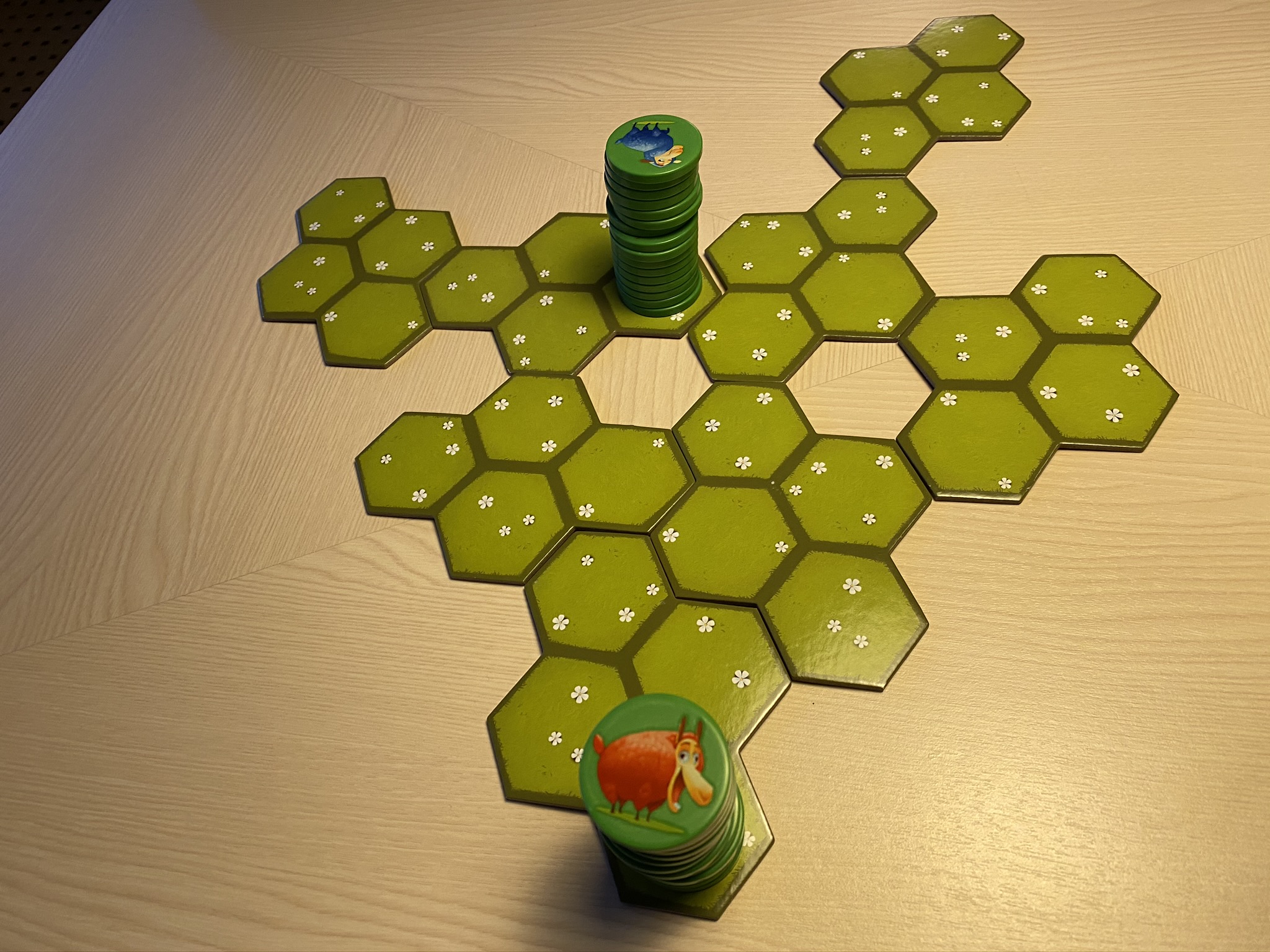
Mow
(Age: 7+, Players: 2-10)
This game can be played in a simple variant and in more strategic variants with special abilities. The simplest variants I think you can play with kids that know the numbers. On your turn you play a cow card in either ends of the card already in the middle, you have to the cards in the middle in numerical order. If you can’t play a card, you have to remove all the cards from the middle and the number of flies on the cards (not all have them, but they are under the number) as your penalty. The one that gets 100 or move flies loses the game. It can end up being a long game, so maybe playing to 50 points or something (especially with young kids) could be an idea.
You can be mean and try to as quick as possible to have the lowest and the highest card in play, making it almost impossible for the next player to play a card. With the advanced rules there are ways to get you out of these situations, as they bend the rules a bit.
https://boardgamegeek.com/boardgame/38984/mow
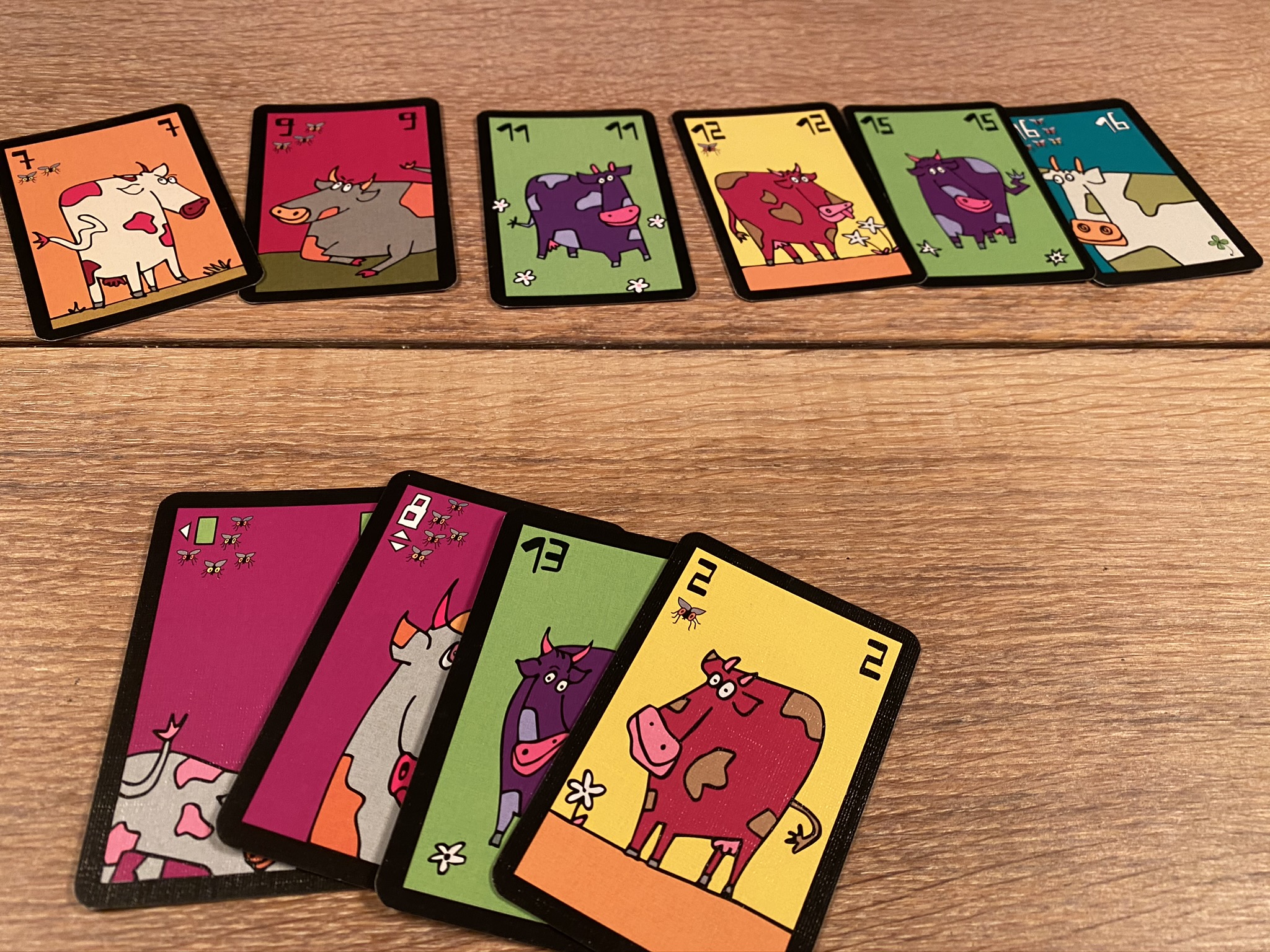
Mole Rats in Space
(Age: 7+, Players: 2-4)
Another co-op game that requires the kids to be a bit older to fully understand and get the most out of the game. This is a very light version of Pandemic, which is made by the same designer. Together you need to gather some resources and escape with the airship but be careful there are quite a few snakes that want to bite you and hinter your way. Shoot the snakes out into the atmosphere to get a longer break before they resurface. You win and lose together so it’s a good game to play with you have people, who are sore losers.
This game might not be the easiest to find, so just be aware of that, and maybe Forbidden Island or Forbidden Desert, without the special abilities could be a way to play.
https://boardgamegeek.com/boardgame/213882/mole-rats-space
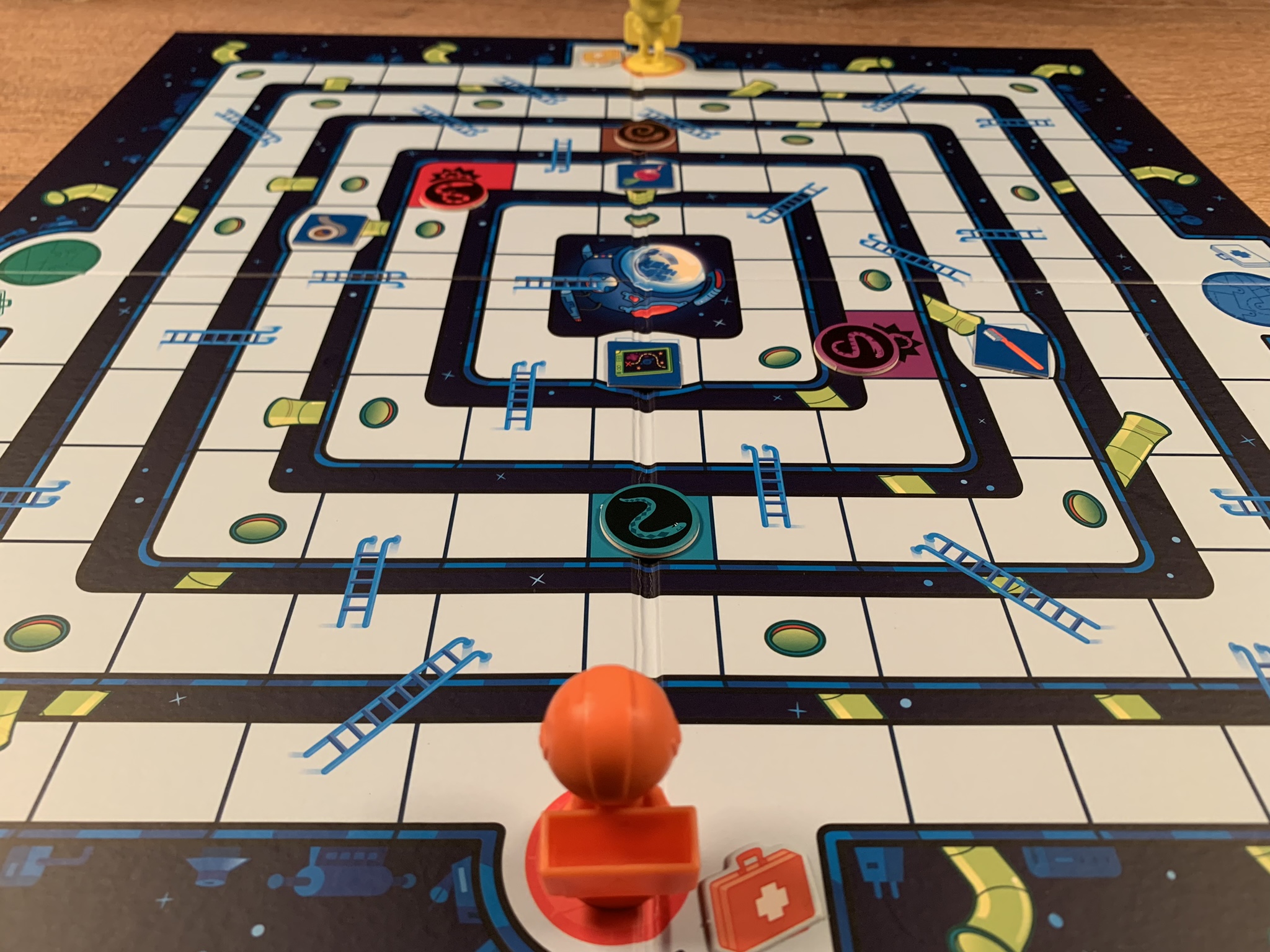
Strike
(Age: 8+, Players: 2-5)
This is one of my most played game, because it plays quick and is so simple you can teach in less than a minute. Everyone can join in and we have used this as a party game as well, with a tournament (with 3 copies).
You use the insert of the board game as the arena where you battle with dice, to be the one standing, who has dice left. The game starts with one die in the middle (not the value x). On your turn you have to throw one die at a time, but at least 1 on your turn. You are trying to get matches, and this might require you to push your luck. If you don’t get a match you can decide to keep going or stop. If you get anything that matches (that includes 2 set of dice matching, two 3s, three 5s) you take all those dice and your turn is over. If you every empty the arena the next player has to thrown in all their dice at the same time and only keep this dice that match, and this is their entire turn – they might get lucky and empty it again for the next play. If a die has the value x or is thrown out of the arena, that die is out of the game. So you play till only one person has any dice left and that person is the winner.
https://boardgamegeek.com/boardgame/123570/strike
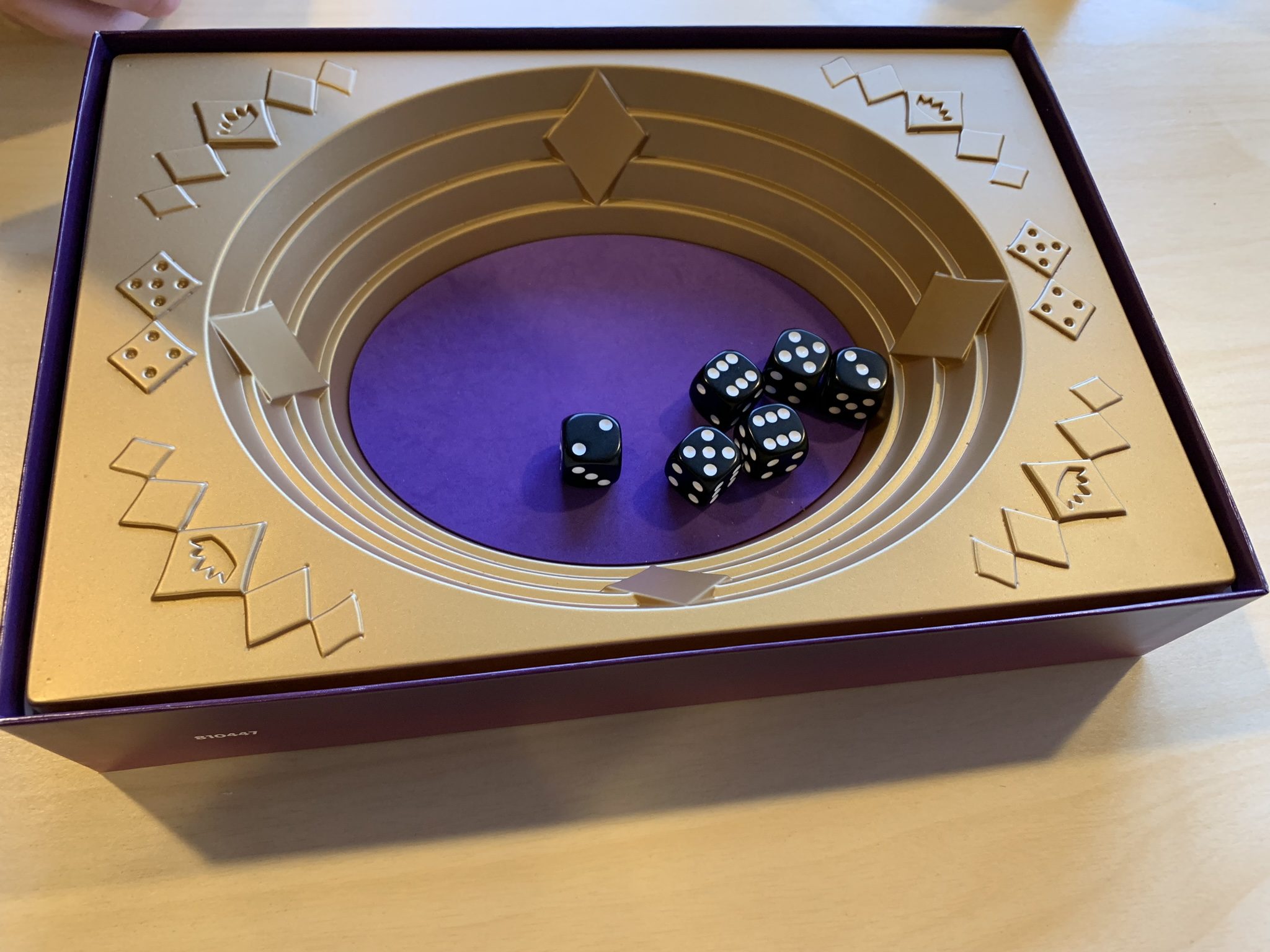
Sushi Go! (or Sushi Go Party – plays up to 8)
(Age: 8+, Players: 2-5 (up to 8 with Sushi Go Party))
Sushi Go! is a card drafting card about, well collecting the best sushi. Everyone gets an equal amount of cards based on player count, and simultaneously you pick a card and reveal it. Then you pass the cards to the next player and do the same, until all cards are on the table.
So how do you pick the best sushi? Well either you take the quick and safe points (the nigiri) or you take a gamble with the sashimi and tempura, as you need 3 or 2 respectively to score points – but other might have taken them or there are not enough in the this round. There is also the wasabi, that only scores when you already had played it and you play your next nigiri on it, then it triples the values!
In the big box “Sushi Go Party” there are quite a lot of variety of sushi, which can be combined in so many ways to create a new game every time.
If you want to play with even younger kids I suggest you change a bit on how the sushi score, until they familiarize themselves with drafting and set collecting.
https://boardgamegeek.com/boardgame/133473/sushi-go
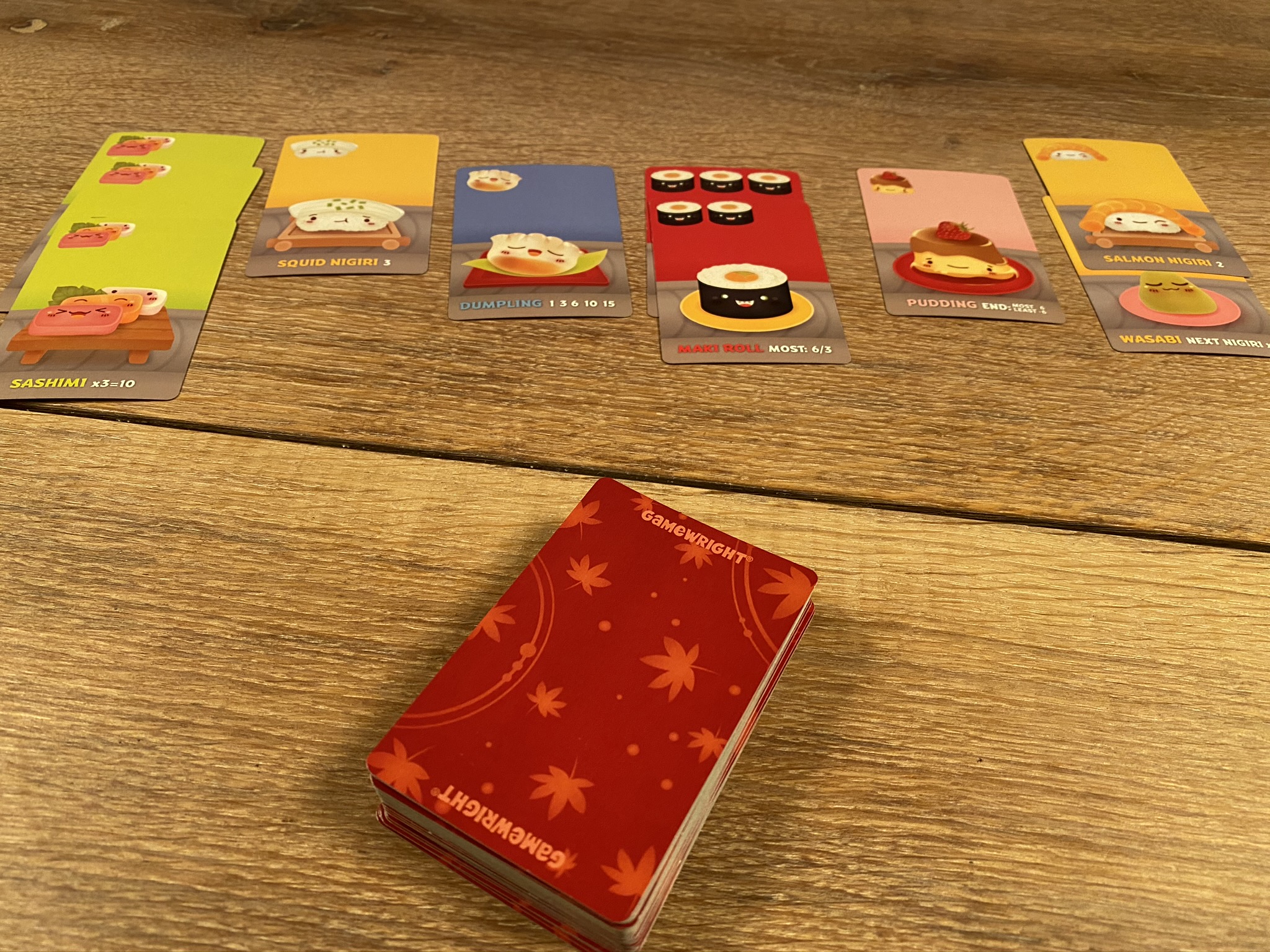
Sushi Roll
(Age: 8+, Players: 2-5)
Sushi Roll obviously has the same mechanisms as Sushi Go! but with dice. There is no hidden information as all the dice are on the table at all times. Every person rolls their dice and the first player takes a die, or uses some bonus tokens before and play continues. After the everyone has gotten one die the sushi conveyor belt is shifted to the next player.
In Sushi Roll the distribution of the die faces are listen on the board, which is quite useful as each colored die is different. Collecting sets of sushi (and playing the wasabi before a nigiri) and end round and game scoring work similar as Sushi Go! What is a little different is the bonus tokens, which every gets from the beginning – a token to be used to swap a die on the conveyor belt with another player or re-rolling as many dice per token as you’d like. Playing in windy weather is a bit better with this dice version 😀
https://boardgamegeek.com/boardgame/271869/sushi-roll
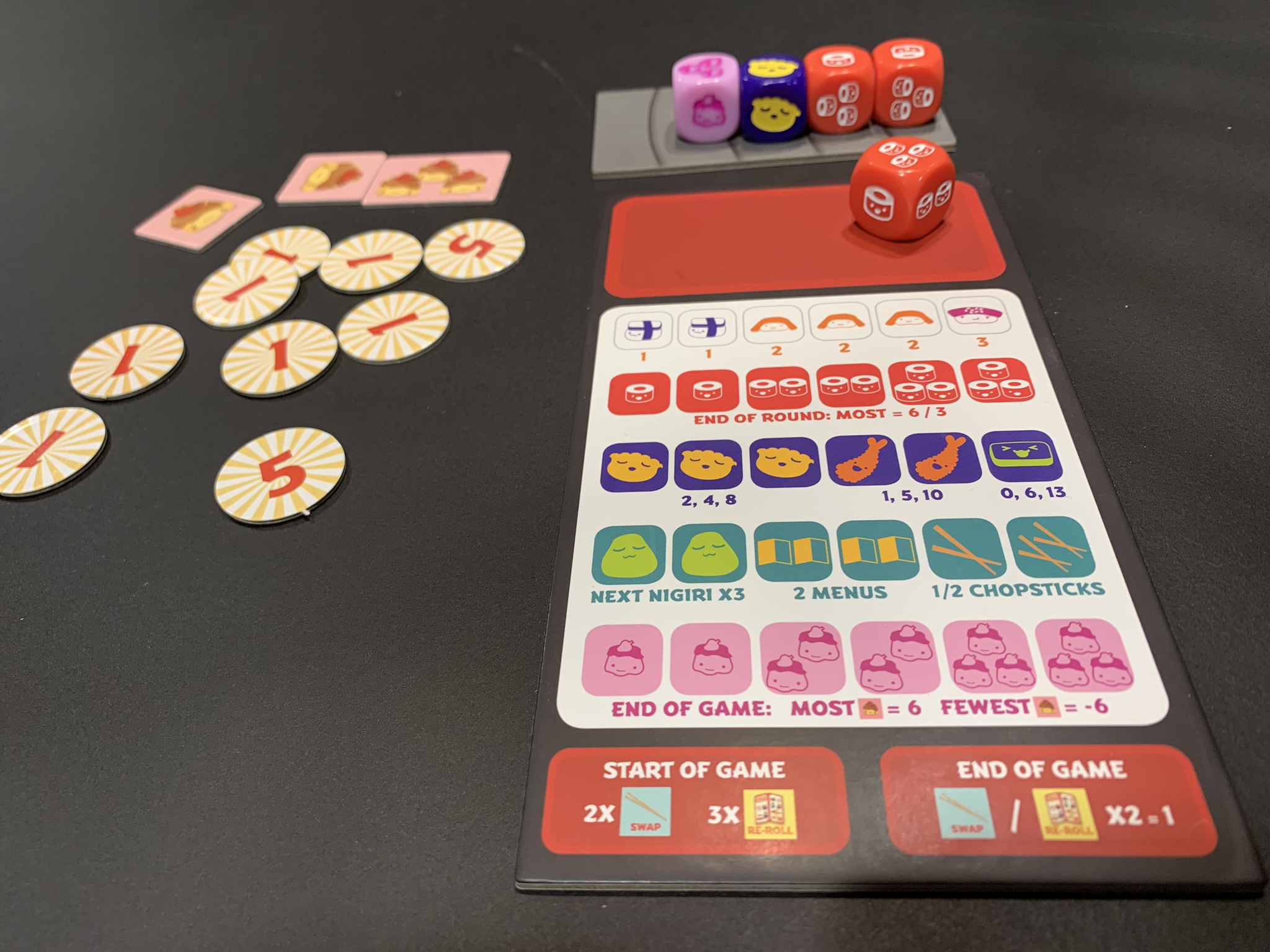
Animals on Board
(Age: 8+, Players: 2-4)
In this set collecting game, you want to fill your Ark with animals with a maximum of 10 animals. The core mechanism in this game is what is known as “I split, You choose” and you start with a number of animals + 1 face down card in the middle of the table depending on player count. You have 2 different actions you can do, but basicly you will mostly be doing the first action, which is splitting a group into 2 new, and thereby getting a food token. Only when you have enough food tokens to pay for each animal in a group, can you take this and be out for the round. The last player get’s 1 final turn before the round ends.
So how do you score points? The main points will come from the animals of course – If you have 1 animal in a species you score the number printed on it, if you have exactly 2 animals – Noa will claim this leaving you with 0 points. So what if you have 3 or more – well then you have a heard and score 5 points per animal – yes this is what you are aiming for.
It sounds like an easy game, but there is actually some strategy to try at get going – do you try your luck with the face down mystery animal or play it more safe? Do you take the 2. animal of a species in hoping to get at least 1 more and not be stuck with just 2 animals?
https://boardgamegeek.com/boardgame/191572/animals-board
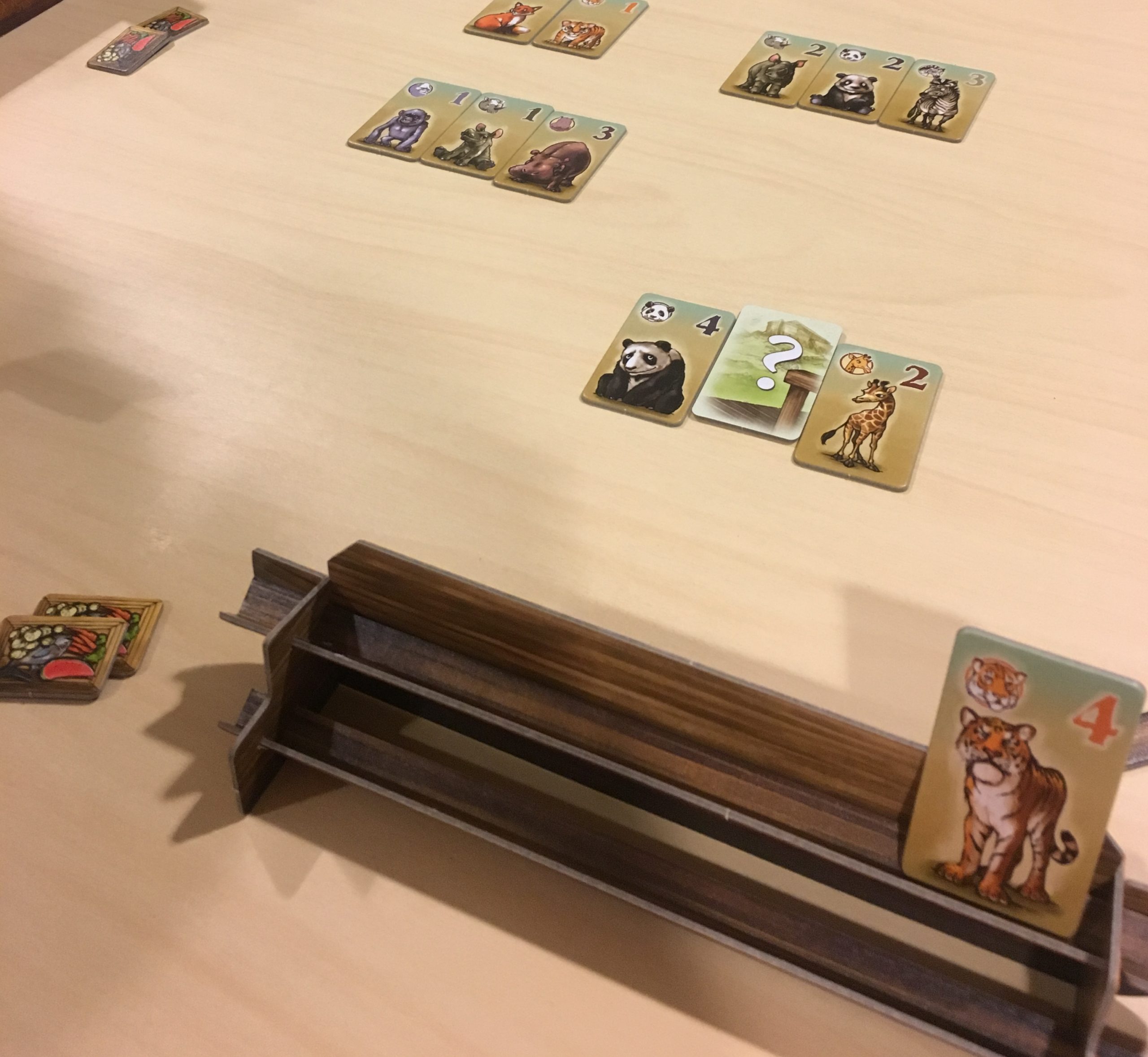
Hey that’s my fish!
(Age: 8+, Players: 2-4)
This games reminds a bit of Battle Sheep, but then again a bit different. You are moving your penguins in straight lines trying to collect the most fish, but also limiting your opponents movement – stranding them on floes. At some point the areas are all split and you can just grab all the fish for that particular player. It can be quite strategic, but younger kids might just play without the strategic part, but it seems to be a good game to develop some strategic thinking.
On my picture it has a 3D printed holder for all the floes which doesn’t come with the game, but very handy as it can be a bit fiddly when you need to take middle floes out.
https://boardgamegeek.com/boardgame/8203/hey-s-my-fish
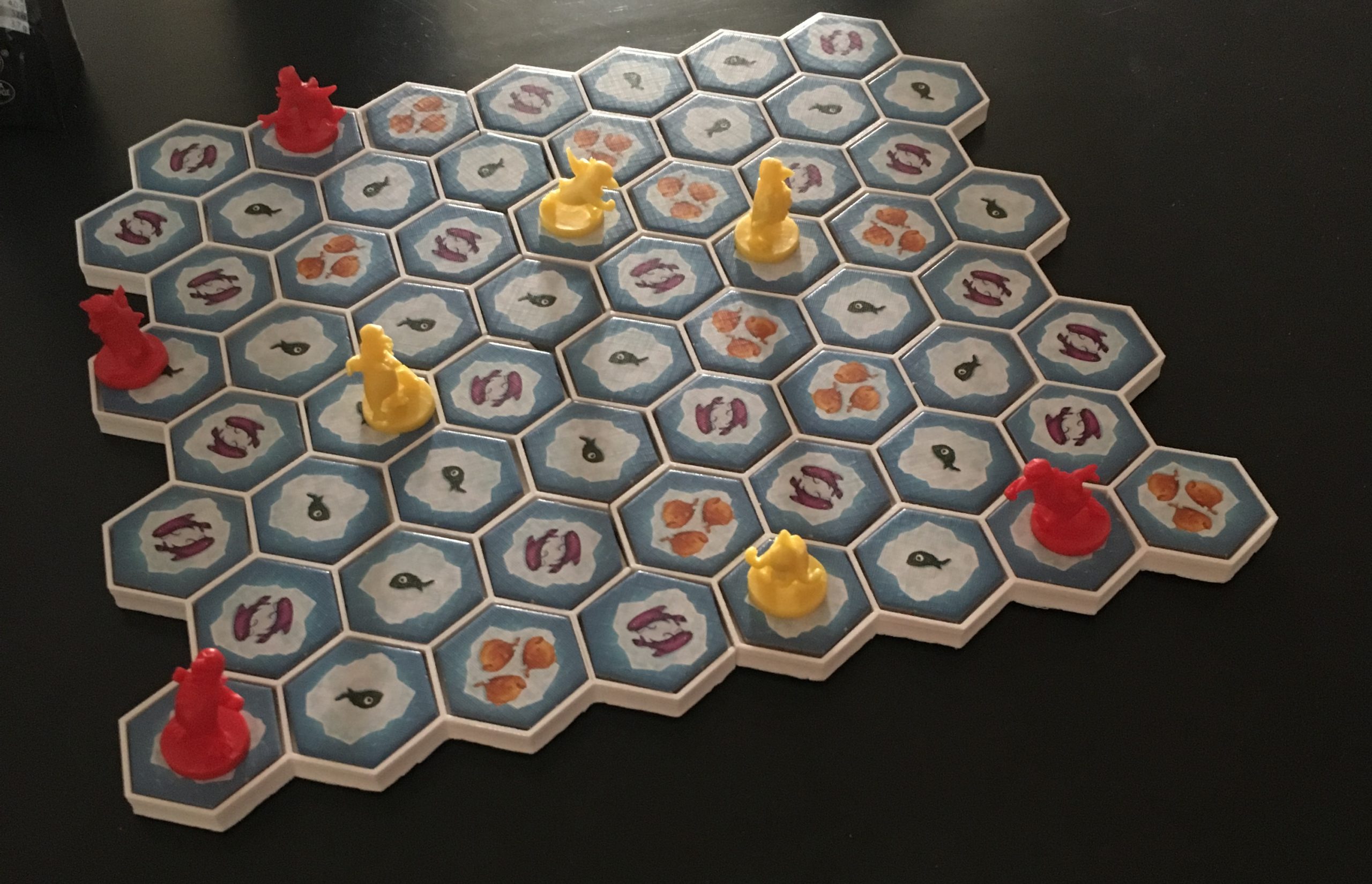
Drop It
(Age: 8+, Players: 2-4)
Very simple game with a fun randomness of the pieces you literally have to drop in. Each player gets a color (2 colors for a 2 player game and there are team variants as well). Your job is to put one piece at a time in, alternating between players, and scoring. When you drop the piece in (4 different shapes) you have to avoid it touching the same color or shape, as you will then not score any points. It’s so fun seeing how the piece you thought you placed exactly the place you want and it just jumps over at places itself in the worst possible position.
https://boardgamegeek.com/boardgame/244916/drop-it
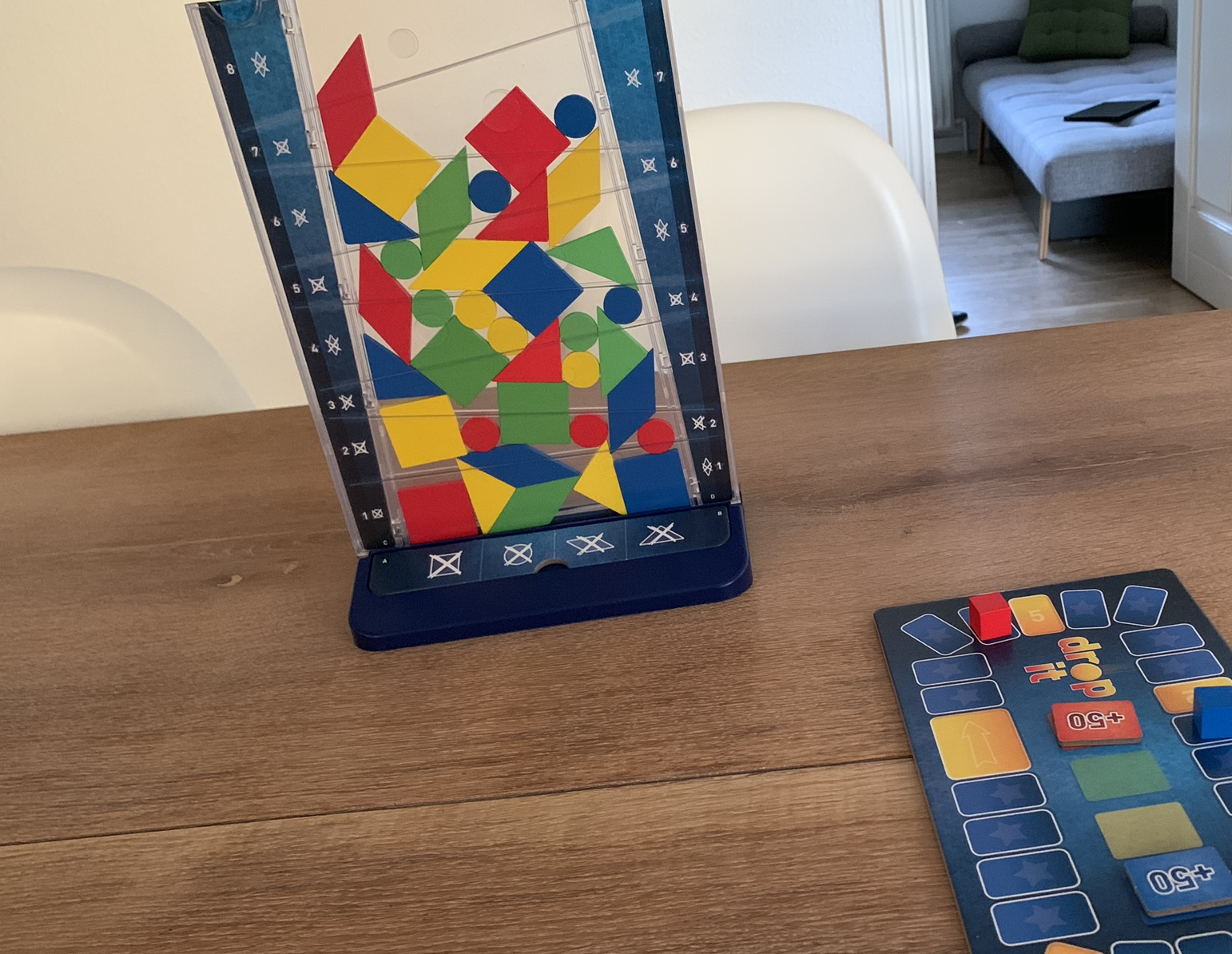
Push a Monster
(Age: 8+, Players: 2-4)
It’s again a simple rule set to this game, but the execution can be hard. You roll the die to see which monster to push onto the platform, but you have to push it so it’s completely inside the platform, with nothing hanging over the edge – and using the rulers to push and not your fingers makes it a bit more tricky. And the tricky part is not pushing any monster off. If you do your opponents gets to have a matching piece for that monster. The thing is the pieces vary in length depending on the monsters size – so some are more “safe” to push off. Line up all the monster pieces and whoever has the longest line wins the game. I think actually small fingers will have an advantage.
https://boardgamegeek.com/boardgame/172542/push-monster
